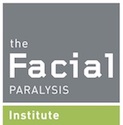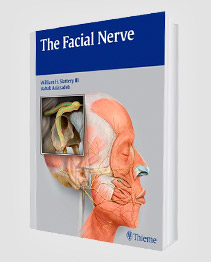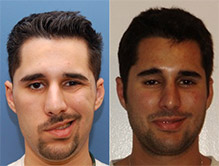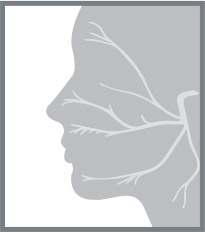Facial paralysis patients often struggle to make facial expressions, as well as chew, swallow and speak. In some instances, facial paralysis patients also experience ophthalmoplegia, also referred to as eye paralysis.
Eye Paralysis: Here’s What You Need to Know
Ophthalmoplegia can affect one or more eye muscles. It has been linked to several medical conditions, including:
- Brain tumor
- Infection
- Migraines
- Stroke
- Thyroid disease
People with diabetes are more prone than others to eye muscle paralysis. In addition, people coping with Graves’ disease, muscle sclerosis, and other conditions that can affect muscle control are susceptible to paralysis of the eye.
How Does the Facial Nerve Affect the Eye?
To understand the correlation between the facial nerve and the eye, consider Bell’s palsy, a primary cause of facial paralysis in the United States.
Bell’s palsy can paralyze the facial nerve used to control muscles for the eyelids, forehead, and other parts of the face. It typically causes facial paralysis on one side of the face. The condition sometimes affects the eye and eyelid muscles and makes it tough for an individual to blink properly, too.
Without the ability to blink normally, a Bell’s palsy patient cannot keep their eye moist. This can lead to extreme eye dryness and inflammation. Also, a Bell’s palsy patient may be more susceptible than others to keratitis, inflammation of the cornea (clear tissue on the front of the eye).
Along with keratitis, Bell’s palsy patients may be more prone than others to eye pain and blurred vision. If a Bell’s palsy patient’s eyelid does not function properly, he or she may struggle to fully close their eye while trying to sleep as well.
Bell’s palsy is one of several facial nerve problems that can cause simultaneous facial and eye muscle paralysis. Other facial nerve issues linked to facial and eye paralysis include:
- Infection
- Stroke
- Facial nerve trauma
Facial nerve problems can cause temporary or permanent eye paralysis. People dealing with these issues are prone to a sagging lower eyelid, droopy brow, or a watery eye. Facial nerve issues can also result in paralysis of the lower half of the face. This can lead to drooling, sagging of the corner of the mouth, and other issues that occur in conjunction with eye paralysis.
What to Do If You Experience Eye Paralysis
Eye muscle paralysis can cause any of the following symptoms:
- Double and/or blurred vision
- Difficulty moving both eyes in every direction
- Drooping of the eyelids
Do not wait to treat paralysis of the eye, regardless of whether the problem is occurring on its own or in combination with facial palsy. By seeking out immediate medical treatment, an individual can address paralysis of the eye and any other symptoms before they can cause long-lasting damage.
For people who experience eye paralysis symptoms, consult with an ophthalmologist. From here, a patient can undergo a physical examination to check their eye movements. The opthamologist may also request an MRI or CT scan to further evaluate the eye.
Blood tests can be used in combination with the aforementioned eye muscle paralysis assessments. The tests can be used to determine if a patient is dealing with thyroid disease or another condition that causes their eye paralysis symptoms. They can be performed by a neurologist or eye specialist and help a patient receive a proper diagnosis for their paralysis of the eye.
What Eye Paralysis Treatment Options Are Available?
The ideal eye paralysis treatment depends on the patient, the severity of their symptoms, the root cause of these symptoms, and other factors. As such, each treatment for eye paralysis must be tailored to the patient.
Children born with eye muscle paralysis can learn how to compensate for the condition over time. In these instances, they require no additional treatment for their paralysis.
Comparatively, adults coping with paralysis of the eye may require special glasses. They may also wear an eye patch, which can help correct double vision caused by eye paralysis.
What Is the Best Treatment for Eye Paralysis and Facial Palsy?
There is no shortage of eye protection solutions available to facial paralysis patients struggling with eye problems. Common eye protection solutions include:
- Artificial Tears: Lubricate the eyes and help the eyes maintain moisture. Oftentimes, artificial tears need to be used at least once an hour to keep the eyes moist.
- Eye Ointment: Treats eye infections, inflammation and soreness. An eye ointment usually requires a prescription, but over-the-counter options are available to treat dry eyes.
- Medical Tape or Eye Patch: Prevents an air conditioner or ceiling fan from drying out an eye. Medical tape can be used to keep an eye shut, and an eye patch can be worn both during the day and at night as needed.
The aforementioned eye protection solutions sometimes help facial paralysis patients treat their eye issues. Yet, these eye protection solutions offer no guarantees. If an individual experiences long-term eye dryness and other facial paralysis symptoms, eyelid weights may be beneficial.
What Are Eyelid Weights?
Eyelid weights can treat incomplete eyelid closure associated with facial paralysis. The weights are made of gold or platinum and can be implanted into a facial paralysis patient’s upper eyelid. They can help the patient regain the ability to blink properly.
Extensive planning is required before an eyelid weights procedure. First, a facial paralysis patient must be fitted for eyelid weights. Facial plastic and oculoplastic surgeons can work together to determine the appropriate size of the patient’s eyelid weights. They can also determine if gold or platinum weights can deliver the optimal treatment results.
Eyelid weights must be implanted with precision and care. A patient is closely monitored following an eyelid weights procedure. If the patient has concerns or questions or experiences any eye issues after treatment, he or she should notify their surgeon immediately.
Are Eyelid Weights Safe and Effective to Treat Eye Muscle Paralysis?
The safety and efficacy of eyelid weights and other facial and eye muscle paralysis treatment options varies. In the event that a patient experiences eye muscle weakness or paralysis, consult with a opthamologist. And, if eye paralysis escalates and occurs in conjunction with facial paralysis, meet with Dr. Babak Azizzadeh of The Facial Paralysis Institute.
Dr. Azizzadeh is a world-renowned facial plastic and reconstructive surgeon. He takes a holistic approach to facial paralysis treatment. By doing so, Dr. Azizzadeh helps each patient address eye paralysis and other facial paralysis symptoms.
How Does Dr. Azizzadeh Treat Eye Muscle Paralysis?
For those who experience eye muscle paralysis in combination with facial paralysis, Dr. Azizzadeh can help. He performs a series of tests to evaluate a patient and determine the optimal treatment. These tests include:
- Ear, nose, and throat (ENT) evaluation
- Neurologic assessment
- Hearing test
- Vestibular test
- Tearing test
- CT scan
- MRI of the internal auditory canal and brain
- Electrophysiologic test
Once Dr. Azizzadeh identifies the best facial paralysis treatment option, he develops a personalized treatment plan. Dr. Azizzadeh explains this facial paralysis treatment plan to his patient and responds to any concerns or questions. He also helps his patient prepare for all aspects of facial paralysis treatment and recovery.
Schedule a Facial and Eye Paralysis Treatment Consultation with Dr. Azizzadeh
Eye paralysis can make it tough to see clearly. If the problem occurs at the same time as facial paralysis, the issue may be linked to the facial nerve. And, at this point, Dr. Azizzadeh can perform an evaluation and explore treatment options.
Dr. Azizzadeh offers in-person treatment consultations in Beverly Hills and virtual consultations via Zoom for patients dealing with eye paralysis and other facial paralysis symptoms. To learn more or schedule a consultation with Dr. Azizzadeh, contact us online or call us today at (310) 657-2203.
Request your consultation with Dr. Azizzadeh today
Call us at (310) 657-2203 to schedule an appointment.
Schedule a Consultation




